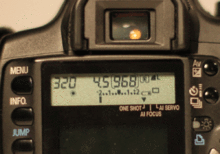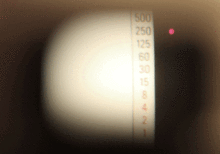- Metering mode
-
In photography, the metering mode refers to the way in which a camera determines the exposure.
Contents
Examples of metering modes
Cameras generally allow the user to select between spot, center-weighted average, or multi-zone metering modes.
Various metering modes are provided to allow the user to select the most appropriate one for use in a variety of lighting conditions.
Spot metering
With spot metering, the camera will only measure a very small area of the scene (between 1-5% of the viewfinder area). This will typically be the very centre of the scene, but some cameras allow the user to select a different off-centre spot, or to recompose by moving the camera after metering. The first spot meter was built by Arthur James Dalladay, editor of The British Journal of Photography in about 1935 and described it in the BJP Almanac of 1937 on pages 127 to 138.[1]
A few models (including the Olympus OM-4, Canon T90 and in the digital world, the Olympus C-5050z) support a Multi-Spot mode which allows multiple spot meter readings to be taken of a scene that are averaged. Some cameras, the OM-4 and T90 included, also support metering of highlight and shadow areas.
Spot metering is very accurate and is not influenced by other areas in the frame. It is commonly used to shoot very high contrast scenes. For example, if the subject's back is being hit by the rising sun and the face is a lot darker than the bright halo around the subject's back and hairline (the subject is "backlit"), spot metering allows the photographer to measure the light bouncing off the subject's face and expose properly for that, instead of the much brighter light around the hairline. The area around the back and hairline will then become over-exposed. Spot metering is a method upon which the Zone System depends.
Another example of spot metering usage would be when photographing the moon. Due to the very dark nature of the scene, other metering methods tend to overexpose the moon. Spot metering will allow for more detail to be brought out in the moon while underexposing the rest of the scene.
Center-weighted average metering
In this system, the meter concentrates between 60 to 80 percent of the sensitivity towards the central part of the viewfinder. The balance is then "feathered" out towards the edges. Some cameras will allow the user to adjust the weight/balance of the central portion to the peripheral one. One advantage of this method is that it is less influenced by small areas that vary greatly in brightness at the edges of the viewfinder; as many subjects are in the central part of the frame, consistent results can be obtained.
Average metering
In this metering mode the camera will use the light information coming from the entire scene and averages for the final exposure setting, giving no weighting to any particular portion of the metered area.
Partial metering
This mode meters a larger area than spot metering (around 10-15% of the entire frame), and is generally used when very bright or very dark areas on the edges of the frame would otherwise influence the metering unduly. Like spot metering, some cameras can use variable points to take readings from, (in general autofocus points), or have a fixed point in the centre of the viewfinder. Partial metering is found mostly on Canon cameras.
Multi-zone metering
This mode is also called matrix, evaluative, honeycomb, segment metering, or esp (electro selective pattern) metering on some cameras. This metering mode was first introduced by the Nikon FA, where it was called Automatic Multi-Pattern metering. On a number of cameras this is the default/standard metering setting. Here the camera measures the light intensity in several points in the scene, and then combines the results to find the settings for the best exposure. How they are combined/calculated deviates from camera to camera. The actual number of zones used varies wildly, from several to over a thousand. However performance should not be concluded on the number of zones alone, or the layout. In general, the most advanced metering is found on single-lens reflex cameras.
Many manufacturers are less than open about the exact calculations used to determine the exposure. A number of factors are taken into consideration, including the following: Autofocus point, distance to subject, areas in focus or out of focus, colours/hues of the scene, and backlighting. Multi-zone tends to bias its exposure towards the autofocus point being used (whilst taking into account other areas of the frame too), thus ensuring that the point of interest has been exposed for properly, (this often means the subject area being exposed for as a mid-tone). A database of many thousands of exposures is pre-stored in the camera, and the processor can use a selective pattern to determine what is being photographed.[2]
Some cameras allow the user to link or unlink the autofocus and metering, and allow the option of locking exposure once AF confirmation is achieved, AEL, (auto-exposure lock). Using manual focus, and on many compacts/bridge cameras, the AF point is not used as part of the exposure calculation, in such instances it is common for the metering to default to a central point in the viewfinder, using a pattern based on that area. There is considerable variation from different manufacturers as to how multi-zone metering is implemented, and even from the same maker in their model range, and how much "priority" is given to the AF point itself. Some "Scene" modes, such as sunset, sports, night exposures etc., also often affect the calculations of this metering pattern.
However, some photographers may be uncomfortable with multi-zone metering. This tends to stem from a lack of clarity about "how" the camera reacts in certain situations. The design concept behind multi-zone is to reduce the need to use exposure compensation.[3]
Some users have problems making wide-angle shots with high contrast, due to the large area which can vary greatly in brightness. It is important to understand that even in this situation, the focus point can be critical to the overall exposure.
References
- ^ Hicks, Roger W. (October 2002). "The SEI Photometer A Legend Among Spot Meters". Shutterbug Magazine. http://www.shutterbug.net/techniques/lighting/1002sb_thesei/. Retrieved 15 December 2009.
- ^ "Exposure Metering". Nikon Corporation. http://imaging.nikon.com/products/imaging/technology/scene/14/index.htm.
- ^ Canon technology description for evaluative metering.[dead link]
External links
- Metering in the Digital Photography Review glossary.
Categories:- Photography equipment
Wikimedia Foundation. 2010.



